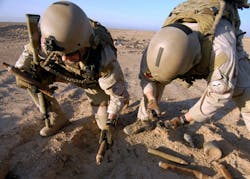Navy researchers ask industry to use unmanned systems to detect and clear unexploded ordnance at airfields
ARLINGTON, Va. – U.S. Navy researchers are asking industry to design lightweight systems to detect and clear unexploded ordnance rapidly in areas as large as military airfields from safe distances.
Officials of the U.S. Office of Naval Research in Arlington, Va., issued a solicitation last week (N0001424SC001) for the Automated Target Recognition for Rapid Area Detection “ATR for RAD” and Rapid Large Area Clearance of Unexploded Ordnance “RLAC” project.
The project has two tracks: automated target recognition for rapid area detection; and rapid large area clearance.
Automated target recognition seeks commercial solutions to enable an automated target recognition for rapid assessment including detection, identification and mapping of unexploded ordnance in large operational airfields. Rapid large area clearance seeks enabling technologies to detect, identify, map, and clear unexploded ordnance at standoff distances. Proposers can participate in both tracks.
Researchers will brief industry on the ATR for RAD and RLAC project from 9:30 to 11:30 a.m. 6 Feb. 2024 at the Holiday Inn Arlington at Balston, 4610 N. Fairfax Drive, in Arlington, Va. Briefings also are available on Microsoft Teams.
Register for the briefings online no later than at Friday 2 Feb. 2024 at https://www.onlineregistrationcenter.com/register/222/page1.asp?m=4269&c=611.
An information package will go to registered industry day participants that includes unexploded ordnance target characterization data, labelled data sets, and the basis for performance metric calculations.
Technologies developed in the ATR for RAD and RLAC project should be able to detect and neutralize unexploded ordnance as small as a golf ball, and as large as 155-millimeter artillery shells. Solutions also should be able to identify other hazards such as impact craters, unexploded ordnance penetrator holes and debris.
The desired solution is an edge-processed capability with a high probability of detection and identification, low false alarm rate, and low circular error of probability for geolocation of unexploded ordnance.
Solutions should be as small as a small-unmanned system with as many as two small unmanned aircraft systems and one medium sized explosive ordnance disposal robot that can survey the airfield autonomously. Solutions for ATR for RAD can be algorithms that can process video feed that can be trained on-site.
Proposers must provide small unmanned aircraft and sensor payloads with well-defined physical and logical interfaces, and that can be trained on site.
Related: Navy orders unmanned ground vehicle
The RLAC capability should involve a modular architecture with known interface control documents for integration with several services and the capability to hand over unexploded ordnance geolocations to tools. It should mitigate or clear with techniques that can be deployed via small unmanned systems.
Companies interested should email unclassified solution briefs no later than 20 Feb. 2024 to the Navy's Jean McGovern at [email protected] and Patrick Smith at [email protected]. Those submitting promising solution briefs may be asks to submit full proposals.
Email technical questions or concerns to the Navy's Jean McGovern at [email protected] and Patrick Smith at [email protected]. Email business questions to Derek Petersen at [email protected]. More information is online at https://sam.gov/opp/221a69be370a4f0cab32cec3560c1ef0/view.
